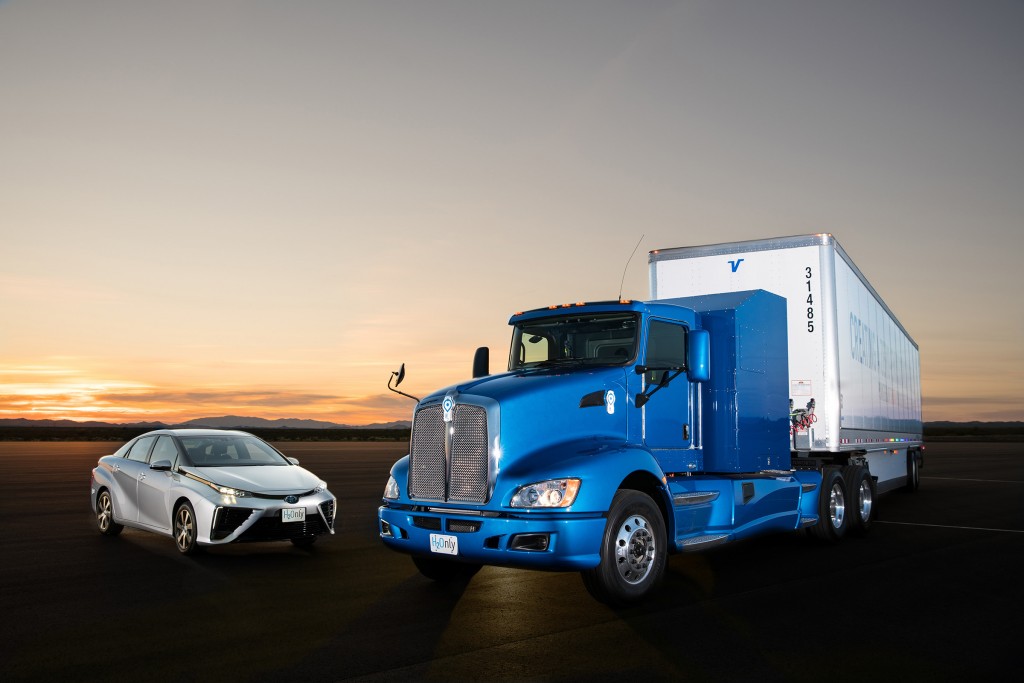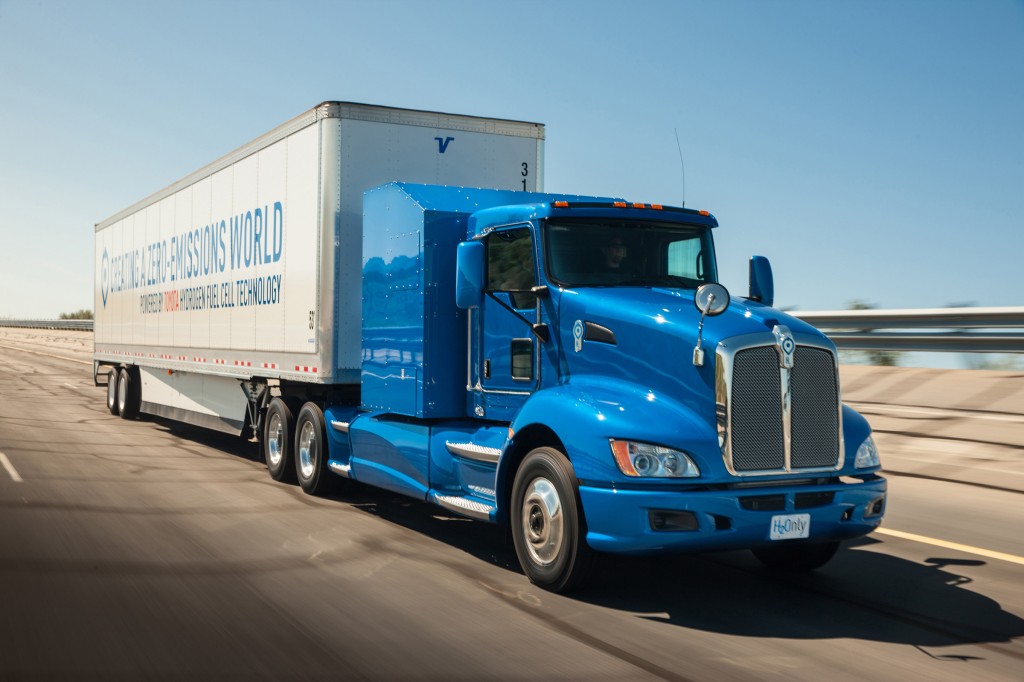Hydrogen could play a major role in emissions reduction by 2030 thanks to the scaling up of low-carbon “green hydrogen” production, the non-profit Rocky Mountain Institute (RMI) explained last week in a blog post.
The carbon footprint of fuel-cell vehicles can vary dramatically based on how the hydrogen they use is produced. Green hydrogen is produced through electrolysis, with electricity generated from renewable sources, to minimize carbon emissions. There should be plenty of electrolysis capacity online by the end of the decade, RMI predicts.
Green hydrogen is ready to scale up this decade because it’s based on “commercially mature technologies” and thus isn’t waiting on any breakthroughs, the group argues, adding that commercial demand for decarbonization is creating a market for green hydrogen.
Toyota ‘Project Portal’ proof-of-concept hydrogen fuel-cell powered semi tractor, for Port of LA
Major shippers like Amazon, Unilever, and Ikea are aiming for full decarbonization of their shipments by 2040 through the Cargo Owners for Zero Emission Vessels (CoZEV) alliance. Fuel cells may be a better fit than batteries for large cargo ships, and Toyota has already demonstrated fuel-cell vehicles in port drayage operations.
Electrolyzer manufacturers are also ramping up production, RMI noted, citing Bloomberg New Energy Finance (BNEF) data showing that machines equivalent to 210 gigawatts of generating capacity could be produced globally by 2027, if all manufacturing capacity is fully utilized.
In many cases, existing natural gas pipelines can be used to transport hydrogen, and it can be stored in geologic salt caverns, according to RMI. Globally, projects to build “hydrogen hubs” around this infrastructure are already underway, with some funding dedicated to them in the 2021 federal infrastructure law.

Toyota ‘Project Portal’ proof-of-concept hydrogen fuel-cell powered semi tractor, for Port of LA
Illustrating the importance of choosing green hydrogen for any future projects, RMI previously warned that these hubs could be as dirty as coal if hydrogen was produced using high-carbon methods, such as extracting hydrogen from natural gas. An early version of the infrastructure bill even discussed coal as a potential source.
So while green hydrogen capacity may be abundant by the end of the decade, regulators need to ensure it’s used. Lax rules could also lead to the proliferation of “blue hydrogen,” which is billed as clean but could still be very carbon intensive. For example, a 2021 study found that a commonly discussed method of reducing emissions by capturing carbon dioxide released during the production process actually produced emissions 20% higher than burning coal.
However it’s produced, hydrogen now seems more likely to be used in commercial trucks than passenger cars. Automakers have been shifting their fuel-cell focus away from passenger vehicles, with Toyota planning to make fuel-cell modules for trucks in the U.S. starting in 2023. General Motors in 2021 announced a program with Navistar to produce 2,000 hydrogen long-haul semi trucks.

buy lasuna pills for sale – cheap lasuna sale buy himcolin online
cost besifloxacin – buy generic carbocysteine buy sildamax generic
buy neurontin 600mg – order sulfasalazine 500mg without prescription order azulfidine 500mg without prescription
oral benemid – buy probenecid 500mg buy tegretol online
buy celebrex pill – celecoxib 100mg over the counter order indomethacin sale
where can i buy mebeverine – cilostazol for sale cost pletal
buy diclofenac sale – aspirin over the counter buy aspirin 75 mg pill
order rumalaya sale – order rumalaya pill amitriptyline 10mg us
where can i buy voveran – buy nimotop for sale buy cheap generic nimotop
buy ozobax without prescription – piroxicam for sale online feldene 20mg us
cyproheptadine 4mg tablet – buy tizanidine generic generic tizanidine 2mg
cheap meloxicam 15mg – buy maxalt 10mg for sale purchase toradol online cheap
purchase trihexyphenidyl pills – order diclofenac gel online how to order voltaren gel
omnicef order online – buy omnicef online cleocin for sale
order isotretinoin 40mg without prescription – purchase isotretinoin generic order deltasone 5mg without prescription
deltasone 20mg cheap – buy omnacortil generic buy permethrin online cheap
acticin brand – purchase benzac without prescription buy retin cream sale
brand betamethasone – differin cream benoquin for sale
cost flagyl 400mg – metronidazole pills cenforce 50mg oral
amoxiclav tablet – buy augmentin medication synthroid buy online
order cleocin 150mg online cheap – buy generic indocin 75mg purchase indomethacin sale
order cozaar 25mg – losartan where to buy order cephalexin 125mg pill
generic crotamiton – crotamiton sale aczone for sale
provigil cost – promethazine 25mg brand order meloset online
order bupropion 150 mg – xenical 120mg us buy generic shuddha guggulu over the counter
cheap xeloda 500 mg – how to buy ponstel order danocrine 100 mg without prescription
order fosamax 35mg online cheap – order alendronate 70mg online cheap cost medroxyprogesterone 5mg
buy generic aygestin 5 mg – cheap norethindrone order yasmin pills
purchase estrace sale – estrace without prescription buy anastrozole
dostinex medication – alesse pills buy generic alesse online
гѓ—гѓ¬гѓ‰гѓ‹гѓі йЈІгЃїж–№ – гѓ—гѓ¬гѓ‰гѓ‹гѓі и–¬е±ЂгЃ§иІ·гЃ€г‚‹ г‚ўг‚ёг‚№гѓгѓћг‚¤г‚·гѓіг‚ёг‚§гѓЌгѓЄгѓѓг‚Ї йЂљиІ©
г‚·гѓ«гѓ‡гѓЉгѓ•г‚Јгѓ« йЈІгЃїж–№ – г‚·гѓ«гѓ‡гѓЉгѓ•г‚Јгѓ« гЃЇйЂљиІ©гЃ§гЃ®иіј г‚їгѓЂгѓ©гѓ•г‚Јгѓ«гЃЇи–¬е±ЂгЃ§иІ·гЃ€г‚‹пјџ
eriacta lighter – zenegra misery forzest present
buy indinavir cheap – cheap fincar sale emulgel online order
valif want – order sustiva 10mg generic brand sinemet 10mg
ivermectin 3 mg over the counter – ivermectina 6mg order carbamazepine 400mg online
deltasone online order – buy captopril 25 mg without prescription capoten 120mg generic
generic deltasone 40mg – buy generic capoten 25mg captopril cost
generic accutane – purchase dexamethasone pill zyvox where to buy
amoxil us – cheap valsartan ipratropium over the counter
cost azithromycin 500mg – buy tindamax 300mg for sale buy nebivolol generic
buy prednisolone 5mg – omnacortil drug buy prometrium 100mg online cheap
neurontin 600mg over the counter – gabapentin 600mg cheap buy sporanox medication
oral furosemide – order betnovate sale3 buy betamethasone 20 gm for sale
clavulanate cost – order cymbalta 20mg pill cymbalta 20mg oral
doxycycline medication – buy glipizide 10mg pill glucotrol cost